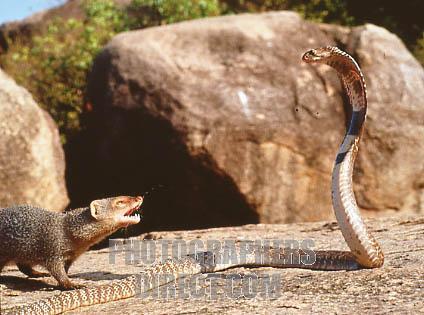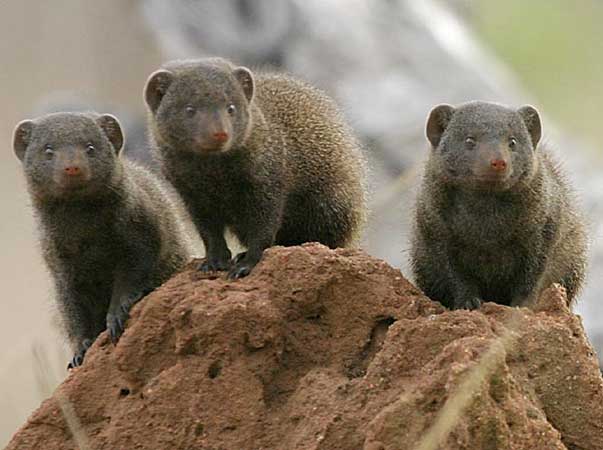There are more than thirty species, ranging from 1–4 feet (0.30–1.2 m) in length. Mongoose range in weight from the squirrel-sized Common Dwarf Mongoose, at 10 oz (280 g), to the cat-sized White-tailed Mongoose, at 9 lb (4.1 kg).
Mongooses bear a striking resemblance to mustelids, having long faces and bodies, small rounded ears, short legs, and long tapering tails. Most are brindled or grizzly; few have strongly marked coats. They have non-retractile claws that are used primarily for digging. Mongooses, much like goats, have narrow, ovular pupils. Most species have a large anal scent gland, used for territorial marking and signaling reproductive status. The dental formula of mongooses is similar to that of vi-v-er-rids: . Mongooses also have receptors for acetylcholine that, like the receptors in snakes, are shaped so that it is impossible for snake neurotoxin venom to attach to them. Researchers are investigating whether similar mechanisms protect the mongoose from hemotoxic snake venom'sThe mongoose has a very similar appearance to the weasel, despite not being closely related. Their long sleek bodies and short fur fit them for similar ecological niches. They live in similar climates and both burrow underground. Like weasels, mongooses also have short legs and tailsMongooses mostly feed on insects, crabs, earthworms, lizards, snakes, chickens, and rodents. However, they also eat eggs and carrion.
. Mongooses also have receptors for acetylcholine that, like the receptors in snakes, are shaped so that it is impossible for snake neurotoxin venom to attach to them. Researchers are investigating whether similar mechanisms protect the mongoose from hemotoxic snake venom'sThe mongoose has a very similar appearance to the weasel, despite not being closely related. Their long sleek bodies and short fur fit them for similar ecological niches. They live in similar climates and both burrow underground. Like weasels, mongooses also have short legs and tailsMongooses mostly feed on insects, crabs, earthworms, lizards, snakes, chickens, and rodents. However, they also eat eggs and carrion.Some species lead predominantly solitary lives, seeking out food only for themselves, while others travel in groups, sharing food among group members.
 |
| INDIAN MONGOOSE,GOING TO FIGHT WITH A SNAKE. |
The Indian Mongoose and others are well-known for their ability to fight and kill venomous snakes, particularly cobras. They are adept at such tasks due to their agility, thick coat, and mutated acetylcholine receptors, which render them resistant or immune to snake venom. They typically avoid the cobra and have no particular affinity for consuming its meat.
The mongoose emits a high-pitched noise, commonly known as giggling, when it mates.Some species can learn simple tricks. They can be domesticated and are kept as pets to control vermin. However, they can be more destructive than desired: when imported into theWest Indies to kill rats and snakes, they destroyed most of the small, ground-based fauna. For this reason, it is illegal to import most species of mongoose into the United States,Australia, and other countries. Mongooses were introduced to Hawaii in 1883, and have had a significant negative effect on native species.
 |
| MARSH MONGOOSE. |
- Genus Atilax
- Marsh Mongoose, Atilax paludinosus
- Genus Bdeogale
- Bushy-tailed Mongoose, Bdeogale crassicauda
- Jackson's Mongoose, Bdeogale jacksoni
- Black-footed Mongoose, Bdeogale nigripes
- Sokoke Bushy-tailed Mongoose, Bdeogale omnivora
- Genus Crossarchus
- Genus Cynictis
- Yellow Mongoose, Cynictis penicillata
- Genus Dologale
- Pousargues' Mongoose, Dologale dybowskii
- Genus Galerella
- Angolan Slender Mongoose, Galerella flavescens
- Somali Slender Mongoose, Galerella ochracea
- Cape Gray Mongoose, Galerella pulverulenta
- Slender Mongoose, Galerella sanguinea
- Genus Helogale
- Ethiopian Dwarf Mongoose, Helogale hirtula
- Common Dwarf Mongoose, Helogale parvula
- Genus Herpestes
EGYPTIAN MONGOOSE. - Herpestes auropunctatus
- Short-tailed Mongoose, Herpestes brachyurus
- Indian Gray Mongoose, Herpestes edwardsii
- Indian Brown Mongoose, Herpestes fuscus
- Egyptian Mongoose, Herpestes ichneumon
- Small Asian Mongoose, Herpestes javanicus
- Long-nosed Mongoose, Herpestes naso
- Collared Mongoose, Herpestes semitorquatus
- Ruddy Mongoose, Herpestes smithii
- Crab-eating Mongoose, Herpestes urva
- Stripe-necked Mongoose, Herpestes vitticollis


No comments:
Post a Comment